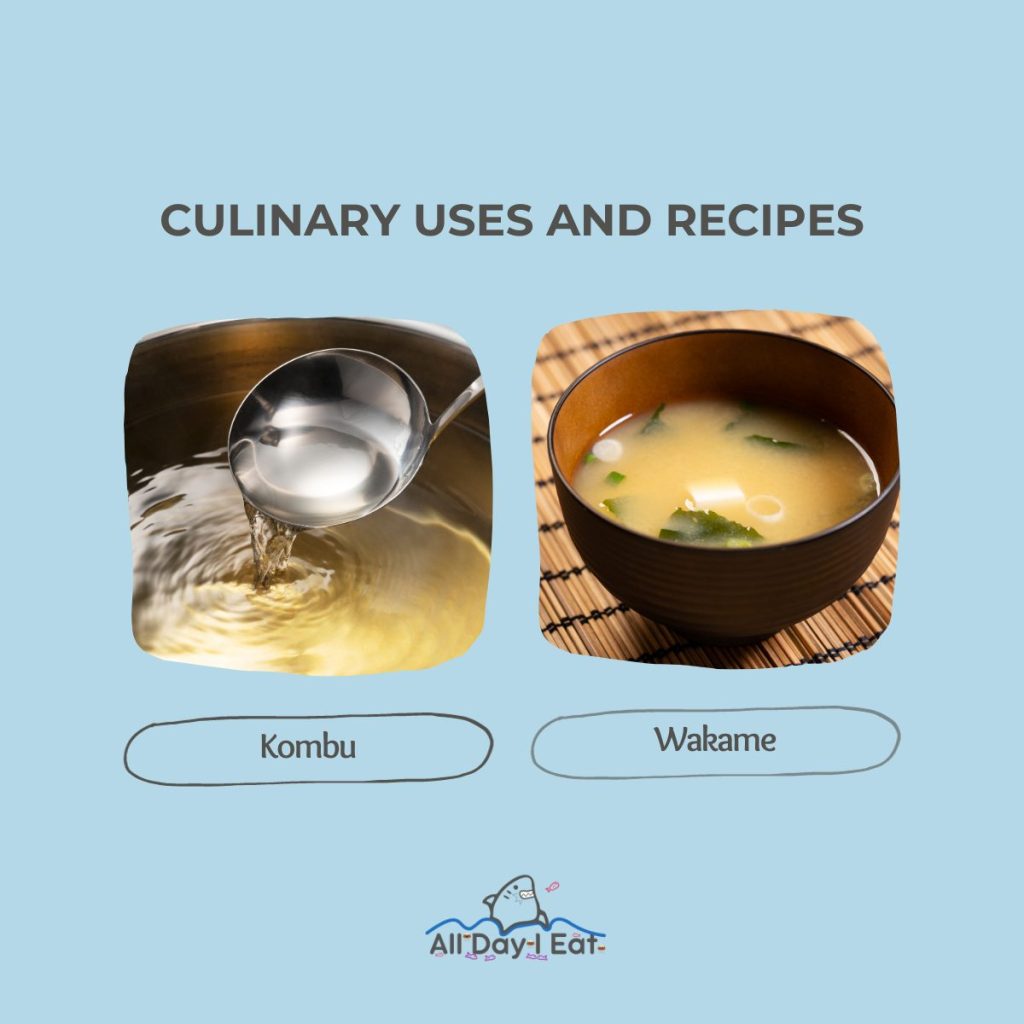Are you curious about kombu vs wakame? Look no further! This article will explore the taste, texture, culinary uses, nutritional value, and availability of these two seaweed varieties.
By the end, you’ll better understand which seaweed best suits your cooking needs. So, let’s dive in and discover the unique characteristics of kombu and wakame!
Key Takeaways

- Kombu has a rich umami flavor, while wakame has a milder flavor.
- Kombu has a thick and chewy texture, while wakame is tender and delicate.
- Kombu is commonly used to make dashi and adds depth of flavor to soups and stews, while wakame is often used in miso soup, salads, and stir-fries.
- Kombu is a rich source of iodine and minerals, while wakame is low in calories and fat and a good source of vitamins and minerals.
Kombu vs Wakame: Taste and Flavor Profile

Regarding taste and flavor profile, kombu vs wakame differ due to their unique composition and preparation methods.
Kombu, a type of kelp, has a rich umami flavor that adds depth to dishes. Its taste is often described as savory, slightly sweet, and briny. The texture of kombu is thick and chewy.
On the other hand, wakame, a seaweed commonly used in soups and salads, has a milder flavor. It’s slightly sweet with a subtle hint of oceanic saltiness. The texture of the wakame is tender and delicate.
Both seaweeds provide an array of essential minerals and vitamins, making them popular choices in Japanese cuisine.
Ultimately, the choice between kombu and wakame depends on the desired taste and texture of a particular dish.
Kombu vs Wakame: Texture and Appearance

To compare the texture and appearance of kombu vs wakame, consider how they differ in physical characteristics and visual appeal.
Kombu is a type of kelp that’s thick and leathery in texture. It has a smooth surface and can range in color from dark brown to green.
On the other hand, Wakame is a type of thin and tender seaweed. It has a delicate, crinkled appearance and is typically a vibrant green.
Kombu becomes soft and slippery when cooked, while wakame retains its tender texture.
In terms of visual appeal, kombu’s dark color and smooth surface can add depth and richness to dishes, while wakame’s vibrant green color can bring a pop of freshness.
Kombu vs Wakame: Culinary Uses and Recipes

If you’re wondering how to use kombu and wakame, let’s explore their culinary uses and some delicious recipes.
With its strong umami flavor, Kombu is commonly used to make dashi, a traditional Japanese broth. It can also add depth of flavor to soups, stews, and braised dishes. Kombu can be rehydrated and used as a wrap for sushi or added to salads for a nutritious boost.
On the other hand, wakame is often used in miso soup, salads, and stir-fries. It has a mild flavor and a tender texture, making it a versatile ingredient. Add wakame to your next seafood dish, or use it as a garnish for a burst of color and flavor.
Now that you know how to use kombu and wakame, it’s time to get creative in the kitchen and enjoy the unique flavors in your favorite recipes.
Kombu vs Wakame: Nutritional Comparison

To compare the nutritional value of kombu vs wakame, look at their respective profiles.
Kombu, a type of kelp, is known for its rich source of iodine, which is essential for proper thyroid function. It also contains significant other minerals like calcium, magnesium, and potassium.
On the other hand, Wakame is a type of seaweed that’s low in calories and fat, making it a great addition to a balanced diet. It’s a good source of vitamins A, C, and E and minerals such as iron and calcium.
Both kombu and wakame contribute to a healthy diet and offer unique nutritional benefits, so incorporating them into your meals can be a wise choice.
Kombu vs Wakame: Availability and Storage Tips

Regarding availability and storage tips for kombu and wakame, you can easily find both types of seaweed in Asian markets or the international section of your local grocery store.
Kombu is often sold in long strips or sheets, while wakame is typically sold in smaller pieces or flakes. Both types of seaweed are usually dried and packaged, making them convenient to store for long periods.
To keep your kombu and wakame fresh, it is recommended to store them in a cool, dry place away from direct sunlight. Additionally, you can extend their shelf life by transferring them to airtight containers or resealable bags.
Here is a table summarizing the availability and storage tips for kombu and wakame:
| Kombu | Wakame | |
|---|---|---|
| Availability | Asian markets, grocery stores | Asian markets, grocery stores |
| Storage | Cool, dry place away from sunlight | Cool, dry place away from sunlight |
| Packaging | Long strips or sheets | Smaller pieces or flakes |
| Shelf Life | Long periods | Long periods |
| Storage Containers | Airtight containers or resealable bags | Airtight containers or resealable bags |




Konnichiwa! (Hello!) I'm Pat Tokuyama, a Japanese tofu cookbook author, who travels for music, food, and adventure. If you like Japanese tea, checkout some of the newestorganic japanese tea, matcha bowls and noren and more!
** Curious about the Plant Based Japanese Cooking Club? ** Learn more here!